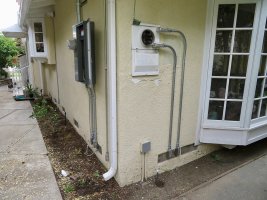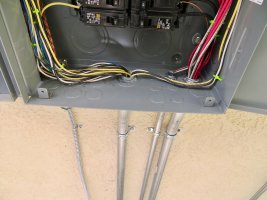ICE
Oh Well

The contractor is convinced that because there is less than 6 ft. between these cabinets in a straight line, ARC fault protection is not required. The 6 ft. exception came into the code years after there was a code that required AFCI if a circuit was extended. It was really a bonus for the electrical contractors as it relaxed the code requirement for AFCI which applied to any extension of a circuit.
But not in my jurisdiction. By my jurisdiction I mean just me....not the AHJ that I work for. You see, prior to the 6 ft. rule it was any extension. That meant that a service upgrade had to be exactly where it was originally. It couldn't even be a foot away from the original location without AFCI.
If you think about the outcome it is clear that the benefit does not always justify the means. Edison relocates service points when spotting a new meter for an upgrade....often. So the AFCI protects the new extended circuit because of the extension and not due to any modification of the rest of the circuit. Essentially as a guarantee of the new work with the added future protection of the circuit. The expense was shocking to many.
I had a rule. Conarb would call it Tiger Code. Everybody else, bullshIt.
Here goes: If the extension is entirely within metallic raceway and on the outside of the structure.....no attic or underfloor....no AFCI is required. The length did not matter.
Then came the six foot rule. It does not require a method, just less than six feet. Okay so now there is another way to thwart the AFCI code. It's not Tiger Code. So I adopted the NEC way and tossed out the Tiger Code. Things went smoother with the Tiger Code.
The job in the picture would have failed no matter what. He genuinely believes that he is correct. He said that he verified the straight line six foot theory with my department and it is accepted universally.
He knows that he did a wrong thing with the number of conductors in a conduit. I know he knows because he said that I wrote that correction on a job they did several years ago. He now needs help with deration. The other violations were all common as well but they do it like this everyday, everywhere.
Hundreds of times a year, thousands if the rest of the contractors are included, the work is done wrong and passes inspection. Houses aren't burning down, people aren't getting electrocuted, and the violations are there. Makes me wonder if it all really matters.

Last edited:
